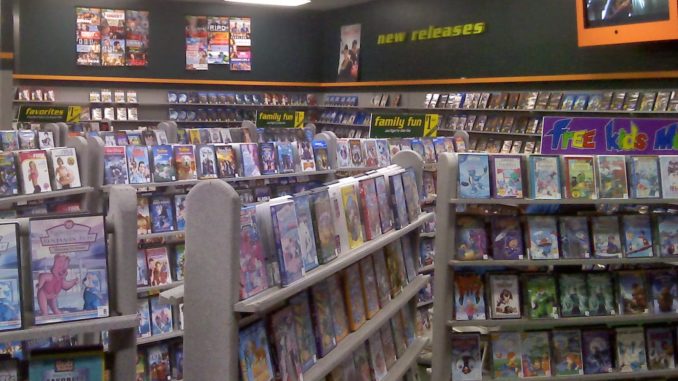
by Christopher Hooker (Twitter: @GoKartMedia)
Back in 1980, I was an eleven-year-old kid growing up in suburban North Florida when video stores began to emerge. It’s odd thinking back on them; a part of life that came, dominated, and went, as I hope I will be able to say about Facebook before I shuffle off this mortal coil.
My family was middle-class, but I would not say we were well-to-do; although we were sheltered in a good home and had plenty of food and our basic needs met, we didn’t buy the latest clothes. We most definitely didn’t compete with neighbors on technology; my dad was savvy about the choices we made and would take his time mulling over the costs before taking a plunge.
But my dad loved movies, and so we were among the first ones on our block to get cable television when it rolled out. When it came out, I remember grown-up” movies being the only thing available, like DEATH RACE 2000 and Robert Altman’s A WEDDING. There were better choices than standard television—and no commercials—but your choices were still limited to what was available.
All that changed with the advent of the VCR. I was the youngest of four kids, and our family did a lot of hand-me-downs. We were never the kind to keep up with the neighbors. My neighbor Aaron’s dad bought his family a Betamax system, and I was incredibly jealous. My dad, after a lot of reading and research, went with the clunky VHS system. Most weekends, me and Aaron would ride our bikes down to the local movie store, and mull over a multitude of choice, both in Beta and VHS.

Mind you, that place wasn’t huge. It was the size of a small bookstore. But it represented a world of film that, weeks before, no one could ever hope to see a majority of. We spent hours looking over titles and casts, trying to decide what movies would be worth the rental fee and the time spent on them, because this was before there was a central point of reference to research films quickly. With no Internet to guide us, sometimes, the best we could do was a Hail Mary on a film. I saw plenty of dogs, but I also saw some really great experiences I might not have ever seen if I hadn’t taken a chance, including MY CHAFFEUR and THE LAIR OF THE WHITE WORM. (MY CHAFFEUR has not aged well, but I still laugh madly at Deborah Foreman trying to calm down a dangerously-drunk Sam J. Jones.)
Perhaps this nostalgia is only really interesting if you knew what life was like before streaming. On your computer, you can access films and television series at any time, some at subscription rates, and others absolutely free. But once upon a time, we didn’t have such access. We didn’t have movie websites. Word of mouth was much more important back then, as were Siskel, Ebert, and those newspapers reporters whose opinions you could generally trust.
It occurs to me now just how vastly important trailers were to a film back then. With no way to watch a trailer online, all you got were the previews at your local Cineplex, the ones tacked on to your rental tape, and pictures in Fangoria. If the trailer didn’t really make skipping a film impossible, you likely would never see the film.
I was a huge fan of horror growing up, and although jump-scares in FRIDAY THE 13th 3 in 3D were still a good laugh, one of the most epic experiences we ever had was watching the made-for-television SALEM’S LOT. Aaron and I watched that in his family room at noon on a Saturday and were out of minds with tension in a way the slasher movies of my generation just didn’t seem to replicate. VHS rentals were a big factor in my tastes as an adult filmgoer; SALEM’S LOT was the first thing Aaron and I watched on their family’s new VHS console.
In the late eighties, My first job was at a deli counter at a gas station that one of my friend’s parents managed. The week I resigned, two aisles were re-configured to be a make-shift video store. That place got the most intense eighties films imaginable: Cynthia Rothrock action flicks, obscure horror and super-low-budget sci-fi, all of it collected at the RaceTrac. It’s where me and my tribe of friends wandered into REANIMATOR and other Lovecraft-bent horror, as well as the only place to carry NEAR DARK in my town. I mean, this was a filling station—your usual overpriced goodies and snacks—and now it had a huge fringe collection of films. The amount of choice we had seemed never-ending.
Of course, my main source for film was locally-owned ‘Movie Stop’. For a small suburban outfit, their selection was just astounding, with well over 1000 films to watch, and plenty of copies of the new releases to keep people excited. Rows of shelves and subgenres you’d never heard of before. The employees were well-versed in filmography, genuinely loved movies and television, and could talk to you about upcoming and out-now theater films, actor resumes, directors, and genres.
Thanks to the George Lucas endorsement and the tutelage of a very kind Movie Stop staffer, I discovered Kurosawa as a kid with KAGEMUSHA: THE SHADOW WARRIOR, and went on to watch SEVEN SAMURAI and YOJIMBO. Under staff recommendations, I watched plenty of brain-melting indies before they were called indies, such as BETTY BLUE and ERASERHEAD.
When I found out through a Turtles employee that Blockbuster bought Turtles Records out in 1989, I went home and congratulated my dad on his initial choice: the VHS had long since won the format battle. As they buyout went into effect, Turtles had been doing long-play clearances and moving onto CDs, and that should have given someone pause, that a smaller laserdisc format would one day come to market. The advent of the DVD meant more shelf-space for films. Eventually, because DVD’s meant a reduction in the cost to make and distribute films, Suncoasts began popping up, where all the obscure titles you could ever want were there for sale. And the employees were knowledgeable without being insufferable, and loved to talk with anyone who shared their niche love (Anime, Martial Arts, obscure indies).
But just as Suncoast had risen due to music storefronts opening in the wake of Napster, the Internet technology grew faster and faster, and soon the means to share entire film libraries online spelled the end for them, too. (Not to mention some disastrous corporate decisions.)
And Netflix, with its ‘forget the store altogether’ concept, began to make Blockbusters obsolete and dated. “What, you go in to a video store and look over 1000 films? Man, I’m looking over 10,000 films.” Plus, Blockbusters weren’t hiring film buffs. They were hiring uninterested teenagers at minimum wages. Video stores had long since stopped being the hubs of people who cared about films. They were as insincere as the average fast food restaurant.
Blockbuster deserved to dwindle and die, I suppose. Whilst I do miss the selection and staff at Suncoast, I don’t really miss Blockbuster Videos. Sometimes, though, I miss that experience of going into a locally-owned store where I could make choices by hand from a limited selection, guided by an employee who cared enough about films to watch them and know vast amounts about them. I miss seeing those rows and rows of boxes in grabbing distance, and making the long walk to a selection…. carrying the film that might be first pick, just in case something better doesn’t occur to me on my travels through the labyrinth of bookshelves where DVDs lurk.
There’s something to be said about the full-service aspect of a video store that’s missing from our lives. Maybe as formats change and as channels begin to fall away for subscription services, they’ll begin to make a slow comeback.
